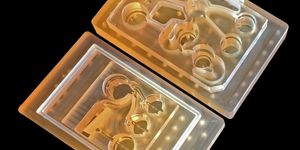Catching Mutations in the Act
Every time a cell divides, it has to replicate its DNA. As an organism goes through life, there are many times cells undergo that process, and it offers many opportunities for errors to be introduced to the genome of that organism. While most mutations don’t have any impact one way or another, some are beneficial and can help organisms evolve. Other genetic mutations, however, can lead to disease and cancer. Now researchers have been able to actually observe these errors happening in bacterial cells.
Reporting in Science, the investigators were also able to determine that mutations happen at a roughly steady rate, as opposed to in bursts. Only about one percent of those errors had a deadly effect, the study found.
For this work, the scientists developed a device they called a mother machine, which would allow bacterial cells to pass through it in a series of channels, one at a time. Some of those cells became trapped within those microscopic channels and held in place as they divided. Any errors that were introduced into the genome could be observed as they happened because the bacteria had been genetically engineered to emit a fluorescent signal when mutations occurred.
A bacteria moved through the device, photos were taken for hours at a time over several days. In all the scientists watched as about 200 generations of bacteria came and went. In normal bacteria, about one mutation happened in a strain of bacteria every 600 hours.
The lead researcher, Lydia Robert of INRA in Paris, told NPR a bit more about how the findings differed from the scientists' expectations. For example, the team learned that cells don’t acquire mutations at different rates.
"We were surprised that in fact, it was not the case," said Robert. Due in part to the redundancy built into the genetic code (in which multiple trios of nucleotide bases code for the same amino acid), the investigators also found that most mutations were harmless.
"Many, many of them had no effect at all. This was a bit of a surprise to me," Robert noted. "I would have expected a lot of mutations to be slightly bad, and they are not even bad at all." Other than the one percent of killer mutations, only 0.2 percent of the rest were detrimental.
"Most of the time it's really neutral. The cell gets a mutation but it does nothing to the cell," said Robert.
Learning more about this process can help investigators understand how they play a role in poor health.








